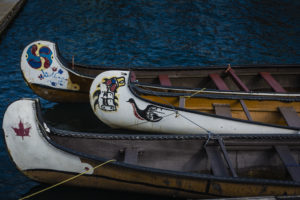Read the Following Selection
Read the following selection, or click on the play button below to listen aloud.
First Nations Communities
First Nations communities were organized by families. They were based on the links between people who were brothers and sisters, parents and children, or uncles and aunts, as well as the ties created by marriage.

Elders
Perhaps the most important people in any First Nations community were the Elders. These men and women were the teachers, and the people who held the knowledge and passed it along. Elders advised leaders so choices could be made that were the best for the whole community.
Decisions were made by consensus, or general agreement. Many First Nations communities still use talking circles to make decisions. In a talking circle, everyone is equal and there is no leader or followers.
From the Elders, the other adults and the children in the community learned about their history, culture, and traditions. The children also were taught by the Elders about their responsibilities to the community. This especially included having respect for all of Creation and the gifts the Creator had given them.

First Nations totem poles at Stanley Park, Vancouver BC
Adults
First Nations men and women shared the responsibility of feeding the community. The men fished and hunted, especially larger animals such as moose and bears. The men traded with other First Nations groups and built homes. When it was necessary, men also fought other First Nations groups to protect their community or to expand it. Men in First Nations communities also cleared land and made it ready for planting.
First Nations women planted and harvested the crops. The women prepared the animals for eating, and dried and scraped the animal skins so they could be used to make clothing. Women hunted small animals and birds, and also gathered berries, nuts, and other foods from the forests around them.
Children
Children were cared for by the entire First Nations community. From an early age, children were taught skills that they would need as adults. For example, boys played games that taught them what they would need to know to fish and hunt successfully. Fathers, brothers, uncles, and grandfathers passed on their knowledge in this way.
Girls needed to learn how to gather food, cook food, prepare animal skins, and sew clothing. They were taught these important skills by their mothers, sisters, aunts, and grandmothers.
Now, show what you know!
Complete some questions about the reading selection by clicking “Begin Questions” below.









